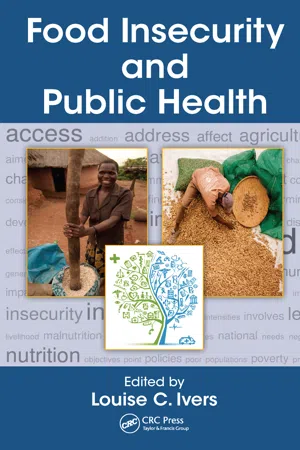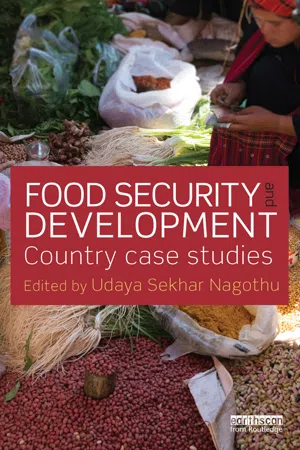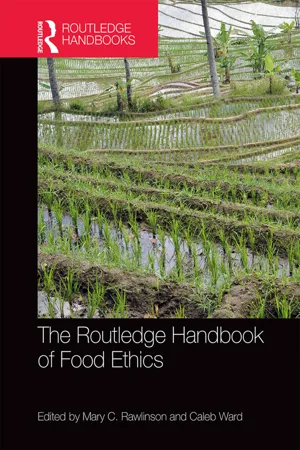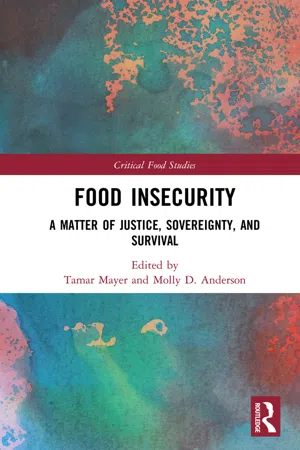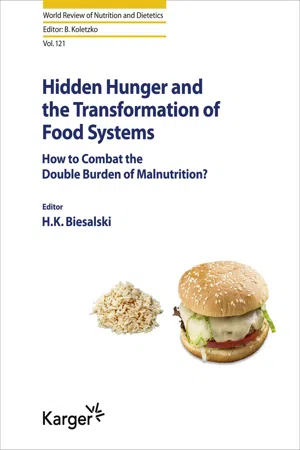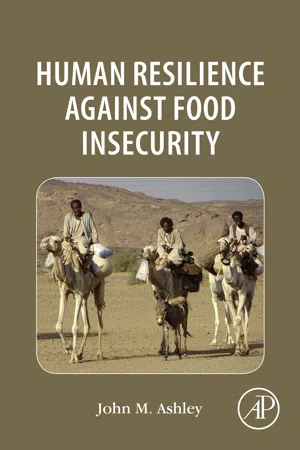Geography
Food Insecurity
Food insecurity refers to the lack of consistent access to enough food for an active, healthy life. It can be caused by various factors such as poverty, conflict, and environmental issues. Food insecurity is a significant concern globally, impacting individuals, communities, and nations, and it is often a focus of geographic studies due to its complex spatial and social dimensions.
Written by Perlego with AI-assistance
8 Key excerpts on "Food Insecurity"
Learn about this page
Index pages curate the most relevant extracts from our library of academic textbooks. They’ve been created using an in-house natural language model (NLM), each adding context and meaning to key research topics.
- eBook - ePub
US Agricultural and Food Policies
Economic Choices and Consequences
- Gerald D. Toland, Jr., William E. Nganje, Raphael Onyeaghala(Authors)
- 2017(Publication Date)
- Routledge(Publisher)
Projections of future global food security conditions are one way to understand the economic factors that influence household nutritional status. We also know that food security is a multi-faceted concept. We should apply a wide-ranging set of analytical techniques to more fully comprehend the causes and consequences of food security (and insecurity).In the final section of this chapter, we consider the question of Food Insecurity from the broad perspective of household access to foods that are both nutritious and reasonably priced. It seems counterintuitive to discuss the US problems of obesity and diet-related diseases as topics related to household Food Insecurity. But there are economic factors that logically link these concerns together.A food-secure household does more than consume at a prescribed level of caloric food intake. Food security implies access to a well-rounded diet.39 Consequently, households who lead healthier lifestyles because they consume balanced and nutritional diets fit a description of food security that is more consistent with a holistic perspective.Food-insecure households in the US may lack the food choices necessary for nutritionally healthy diets. Instead, Food Insecurity can be interpreted to include the household consumption of more readily accessible foods that lack nutritional balance and increase the likelihood of obesity and related dietary problems.40Households in diverse US geographic areas, varying from rural locales to inner-city neighborhoods, may have greater accessibility to convenience stores and fast-food outlets than they do to supermarkets. There are serious concerns about the association between poor diets and the absence of nutritious food options. In a broad sense, this is a food security issue.This question of limited geographic access to nutritional food choices is addressed in the 2008 Farm Bill, where the term “food desert” is formally defined:41A food desert is an area in the United States with limited access to affordable and nutritious food, particularly such an area composed of predominantly lower income neighborhoods and communities. (Title VI, Sec. 7527) - eBook - ePub
- Lenard W. Kaye, Lenard W. Kaye(Authors)
- 2021(Publication Date)
- Routledge(Publisher)
30 Food Insecurity Mary Ellen CamireWhat Is Food Insecurity?
Food Insecurity is the inability to get enough nutritious food; thus, both the quantity and nutritional quality of available food must be considered. The U.S. Department of Agriculture (USDA) Economic Research Service (ERS) has defined four levels of food security: high, marginal, low, and very low (Figure 30.1 ). Hunger may accompany Food Insecurity, but people sometimes opt for less-nutritious and inexpensive foods to avoid hunger. Nutrient-dense foods may be more expensive in rural stores than in their urban counterparts (Hardin-Fanning & Rayens, 2015 ). Food Insecurity may persist steadily throughout a year or occur seasonally (Coleman-Jensen, Rabbitt, Gregory, & Singh, 2019 ).Inadequate financial resources are often responsible for Food Insecurity, but other factors may be involved. For example, the lack of private or public transportation to food stores can be a barrier to acquiring healthful foods in rural areas. Local neighborhood stores may only offer energy-dense foods, making it impossible for consumers to buy fresh fruits and vegetables and other healthful foods. The term “food desert” was coined to describe areas where access to nutritious foods is limited. Rural areas are quite diverse across the U.S., so their food environments cannot be easily characterized (Lenardson, Hansen, & Hartley, 2015 ).Measurement of Food Security
The USDA ERS conducts an annual survey with a Food Security Supplement to estimate the extent and severity of Food Insecurity; this information guides federal aid program allocations. The ten-question survey tool requires yes/no answers or selection of a frequency of occurrence (often, sometimes, never) (Coleman-Jensen et al., 2019 ). An additional eight questions are asked when households include one or more children under the age of 18. A key bias in the ERS’s reporting is the lack of data for homeless individuals. The Food Abundance Index evaluates food access, diversity, quality, density, and affordability (Murrell & Jones, 2020 - eBook - ePub
- Louise Ivers(Author)
- 2015(Publication Date)
- CRC Press(Publisher)
Chapter 3Food Insecurity Measurement
Jennifer CoatesEvolution of Food Security Definitions
The most widely accepted definition of food security is “a state in which all people, at all times, have physical and economic access to sufficient, safe, and nutritious food to meet their dietary needs and food preferences for an active and healthy life” (Food and Agriculture Organization 1996). But it was not always conceived this way, nor was there always such agreement. In the 1990s, Maxwell and Frankenberger identified over 200 variations of the definition, many of them similar but emphasizing different elements of the complex construct (1992). In fact, the Food Insecurity definition, and the policy focus that emerged from it, has evolved tremendously since the 1970s when the term was first used to describe a problem of national and global food availability. By the 1980s, the focus of definition (and the emphasis of the policy response) shifted to describe problems of food access (World Bank 1986). The 1990s ushered in an increasingly holistic definition, both in the United States and internationally, that incorporated elements of preference, quality, safety, and an emphasis on the stability of food access. Food in security was increasingly viewed as a more dynamic concept in the context of risk and risk management, with distinctions made about its severity, duration, and periodicity.Though Food Insecurity is often described as having three pillars (availability, access, and utilization), arguably the ultimate objective is to ensure that individuals can utilize food of sufficient (1) quantity, (2) quality, (3) acceptability, and (4) safety in (5) a secure and stable way. Disaggregating these dimensions and measuring them accordingly should be the objective of any food security measurement effort. At the same time, assessing food availability and household access issues can help to elucidate the causes - eBook - ePub
Food Security and Development
Country Case Studies
- Udaya Sekhar Nagothu, Udaya Sekhar Nagothu(Authors)
- 2014(Publication Date)
- Routledge(Publisher)
One might argue that the global obesity epidemic is another case of Food Insecurity – although in a different vein. Out of the 1.4 billion overweight people, 500 million are obese (WHO, 2013). As an interesting case in point, Townsend et al. (2001) found Food Insecurity and obesity to be positively related in the United States. An influential paper by Maxwell (1996) outlined three main shifts in the debate on food security since the World Food Conference in 1974: from the global and the national to the household and the individual; from a food first perspective to a livelihood perspective; and from objective indicators to subjective perception. For instance, a household may have the means to acquire the necessary food, but some members of the household might be underfed (for various reasons), or the members may lack knowledge of dietary changes. A simple thing such as lack of nutritional knowledge can lead to deficiencies, as happened in post Green Revolution countries when people changed their staple diets from traditional food grains (millets) and pulses to refined wheat and rice, causing a steep decline in the diet’s micronutrient content (Welch and Graham, 1999; Welch, 2002; Graham et al., 2012). What about people who are ‘food secure’, but only have access to unclean water and poor sanitation? If food security is supposed to ensure good health and nutrition, policymakers should design interventions to achieve nutritional security, guided by measurements of health (Pinstrup-Andersen, 2009). This has broadened the debate on food security to include nutritional security. According to the International Fund for Agricultural Development (IFAD), food security is a necessary but insufficient condition for nutritional security - eBook - ePub
- Mary Rawlinson, Caleb Ward, Mary Rawlinson, Caleb Ward(Authors)
- 2016(Publication Date)
- Routledge(Publisher)
FAO (1996) is reasserted, with the specification that the nutritional dimension is integral to food security. There are four main conceptual pillars of such a condition:- Food availability: availability of sufficient quantities of food of appropriate quality.
- Food access: access by individuals to adequate commodities (material resources and/or rights such as access to common resources) for the acquisition of foods enabling the pursuit of a nutritious diet.
- Utilization of food: proper digestion and absorption of nutrients in food through adequate diet, clean water, sanitation, and health care.
- Stability: a population, household, or individual must have access to adequate food at all times, avoiding the risk of losing access to food as a consequence of sudden shocks like an economic or climatic crisis, or cyclical events (FAO 2006 ; for a more articulated discussion of these pillars cf. Rosier 2011 : 1–2).
Failure to meet at least one such requirement risks engendering a condition that is generally named Food Insecurity.It is worth noting that neither the description of food security provided above nor a specification of its four dimensions make any explicit reference to the idea of an adequate food, i.e., a food whose unavailability might engender a condition of insecurity. A different definitory approach, instead, is registered in the following attempt to address the concept of food security from a community-centered perspective. A phenomenon known as community food security (CFS) is for instance defined as a situation in which all community residents obtain a safe, culturally acceptable, nutritionally adequate diet through a sustainable food system that maximizes community self-reliance and social justice (Hamm and Bellows 2003 : 37).1 - eBook - ePub
Food Insecurity
A Matter of Justice, Sovereignty, and Survival
- Tamar Mayer, Molly D. Anderson, Tamar Mayer, Molly D. Anderson(Authors)
- 2020(Publication Date)
- Routledge(Publisher)
The chapters in this volume address such causes in different geographical settings, historical periods, and scales (from the local to the global). But it is important to remember that these scales are neither discrete nor independent of each other and are best described as nested. Therefore, in order to understand Food Insecurity at the most local scale, as analyzed in Chapters 2, 3, 6, 8, 10, 11, and 12 (by Gilbertson, Mazar and Mares, Schmook et al., Harper, Oxfeld, Schwartz, and Yamaguchi and Jung, respectively), we need to include a discussion of the causes of hunger at both the national and global levels; we need to look at the impact of global processes—such as colonialism, neoliberal policies, and global warming—on those who inhabit the local scale and suffer from Food Insecurity the most. Chapters 4, 5, 7, 9, and 13 (by Konstantinidis, Öztürk et al., Dell’Angelo et al., Fuller, and Stapleton, respectively) address Food Insecurity at scales greater than the local. It is also important to learn from the past and understand how national responses to hunger have changed over time. Pierre Fuller does this in Chapter 9, using China’s responses to famines in the nineteenth and twentieth centuries to show how they depend on ideology and the availability of food at the national and local levels. Causes and consequences of Food Insecurity At heart, every instance of Food Insecurity stems from inequitable power relations. Amartya Sen (1999:16) famously declared that famine has never occurred in a functioning democracy. We could say with equal surety that Food Insecurity does not occur in societies in which power is shared equitably; democracy is a manifestation of equity, where the government is responsive to its people. Every case of Food Insecurity in this volume can be interpreted as resulting from unequal access to resources needed for food production, opportunity, or political voice (and often, from all of these together) - eBook - ePub
Hidden Hunger and the Transformation of Food Systems
How to Combat the Double Burden of Malnutrition?
- H.K. Biesalski(Author)
- 2020(Publication Date)
- S. Karger(Publisher)
1 ]. This means that there is an unequal and inequitable distribution. One-third of food available is lost and wasted from production to consumption, and some crops are destroyed in order to maintain market prices. Availability at the national level does not ensure accessibility at the level of the household; this is more a function of economic affordability. The purpose here is to suggest ways of improving food security in a manner that is equitable and also sustainable.Vulnerable Groups for Food Insecurity
There are food-insecure people in every country. The list of vulnerable people for Food Insecurity includes: victims of natural disasters; victims of conflict – internally displaced people, refugees, war victims; people living in informal settlements, migrant workers and their families; marginal populations in urban areas – unemployed, homeless, orphans, street children; at-risk social groups – minorities, illiterate, patients, prisoners, addicts; low-income households, one-parent families; dependents – servants, elderly, handicapped, special needs, pregnant and nursing women, and children. This list is not exhaustive as many people are not available for questioning (no telephones) or do not have a fixed abode (such as those living on rubbish dumps, as may be found outside every large city and in their informal settlements [previously called “slums”]). These latter groups are also not usually on the national census and therefore “do not exist” [2 ]. Considering their lack of access to social services and telephone data collection etc., it follows that most information on the numbers of food-insecure people are underestimates.Governance of Food and Health in Developing Sustainable Food Systems
Both food security and health security (together known as human security) are recognized as fundamental human rights [3 ]. There is a vicious cycle whereby the global food system contributes to the increase in non-communicable chronic disease worldwide (especially diabesity) and thus endangers overall productivity as well as the sustainability of health and food systems. The challenge is to make food systems more equitable, more healthy, and more sustainable [4 - eBook - ePub
- John Michael Ashley(Author)
- 2018(Publication Date)
- Academic Press(Publisher)
During a crisis, fragile states may lack the capacity or institutional framework to implement long-term food security solutions, a situation often compounded by poor governance, conflicts, man-made disasters, malaria, measles, HIV/AIDS, Ebola and other diseases. Where states' governments lack the capacity or the will to address the risks and needs faced by the most vulnerable people, international resources continue to play an important role. Section 2.5 of the earlier book discusses differential vulnerability to food and nutrition insecurity, at community and individual levels. The communities most at risk include the rural poor, urban communities in conflict and slum dwellers, while at individual level it is children, women, the handicapped, sick and infirm. The FAO has established that agricultural production needs to increase by 60% between 2005 and 2050 to enable the projected population of 10 billion people by then to be fed. Already, increasing population pressure on land and water is reducing agricultural productivity and environmental integrity. The earlier book points out that climate change will likely intensify that pressure in the developing world, adding to the difficulty of reconciling food needs with production potential. Food production, storage, distribution and use systems are needed that are equitable and sustainable in all dimensions: economic, social and environmental. On the production side, a more resilient food system can in part be brought about through better technical efficiencies of irrigation systems or introduction of more drought- and/or saline-tolerant crop varieties. Climate change will affect all four dimensions of food security: food availability, food accessibility, food utilization and food systems stability. It will have an impact on human health, livelihood assets, food production and distribution channels, as well as changing purchasing power and market flows


